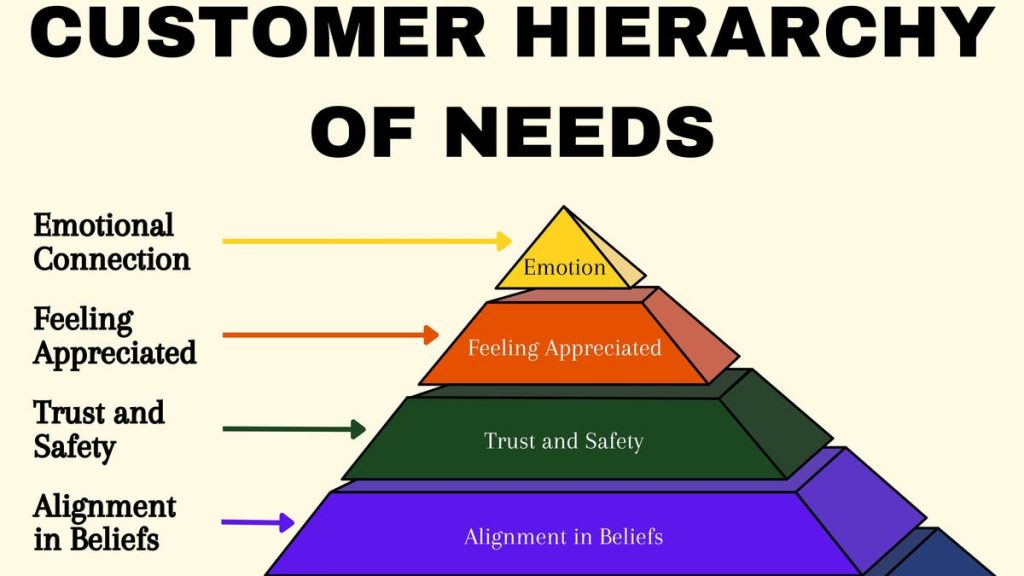Abraham Maslow was an American psychologist who created a model for understanding human behavior. Specifically, he was interested in what motivated people, and he devised five levels in the shape of a pyramid representing each of those needs. For those who need a refresher in psychology, those levels, starting with the basic needs at the bottom and working their way toward the top, are physiological needs (such as food, water and sleep), safety, love and belonging, self-esteem and self-actualization.
I’ve been thinking about a similar model for customers. I’m not a psychologist, and I’ve not done formal research on this idea, but I’ve been studying customer and employee experience in some form for more than 40 years. I’ve identified five areas (at least) that are important to customers when they buy from you and put them into logical order. So, here is the Customer Hierarchy Of Needs:
· Products that Work – We’re starting at the bottom of the pyramid and working our way up. This is the base, and it’s simple: whatever you sell must do what you promise it will do. It doesn’t matter how great your customer service and experience (CX) are, if the product or service doesn’t work, customers will find an alternative.
· Alignment in Beliefs – Your mission and vision statements are your beliefs. Your customers shouldn’t have to read those statements to know what they are. They should experience them when they do business with you. They will quickly learn how you treat them. If they like the experience, they align with you and what you stand for. While that can be enough, they may also enjoy doing business with you because of something that may or may not be in your mission and vision statements. That is a cause, charity or community activity your company or brand is involved with or contributes to. It adds to the emotional connection you’re trying to achieve with your customers.
· Trust and Safety – If the company or brand has a bad reputation, getting and keeping customers will be tough. Even customers willing to take a chance may eventually experience what others have warned them about. Trust and safety belong together, but let’s first discuss trust. A sense of trust comes from different areas that can include (but are not limited to) a good reputation, positive reviews and ratings, customer-friendly policies (like easy returns), simple and frictionless processes, fast response times and friendly, helpful employees. Safety comes from assurances, including data privacy, secure websites, safe physical environments and more. Even if you have products that work—the basic need—without trust and safety, you might not be able to keep your customers past the first sale, assuming you have any at all.
· Feeling Appreciated – Every customer willing to pay you for your goods and services deserves to feel appreciated. If you don’t acknowledge the customer with a simple thank you, they may not notice the first time. But there will be a point at which they feel underappreciated, and when they do, you put yourself at risk of losing them. Never miss an opportunity to express appreciation to your customers.
· Emotional Connection – This is where you move customers from being satisfied to becoming loyal. Satisfied customers come back until something better comes along. Loyal customers come back because they like doing business with you and have made an emotional connection with you. They know your product works, they trust you, you make them feel confident (and safe) when engaging with you, they believe you have a good company and there may even be a cause or charity you mutually support, and every time they interact with you, they feel appreciated. At that point, your customers are feeling emotionally connected to you. Trust and appreciation are emotions. When all the boxes are ticked, you have the emotional connection that drives customer loyalty, advocacy and evangelism.
I could have written an entire article—or even a chapter in a book—on each of these five customer needs. Consider this article as a conversation starter. Perhaps you can add to this list of customer needs. Just because Maslow had five in his model doesn’t mean we are limited to that number.
Next week I’ll cover a similar concept, but instead of customers, I’ll focus on The Employee Hierarchy Of Needs. Stay tuned!
Read the full article here










